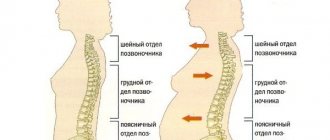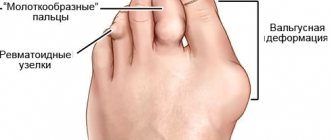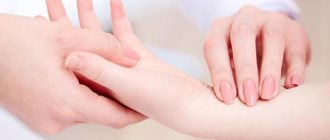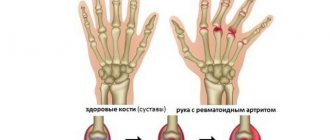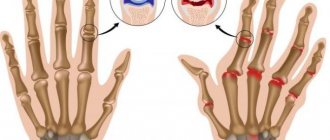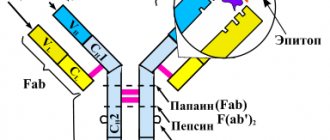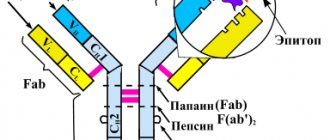Rheumatoid arthritis is a chronic (long-term) disease that causes inflammation and deformation of the joints. Symptoms may come and go or vary, but usually include joint pain, morning stiffness, and limited movement. This condition can be controlled with a combination of treatments.
Rheumatoid arthritis is the second most common form of arthritis and affects 1-2% of the population in Russia. It is three times more common in women than in men. Rheumatoid arthritis occurs in all ethnic groups, climates and altitudes.
Why do women get rheumatoid arthritis more often than men?
Rheumatoid arthritis (RA) is a systemic connective tissue disease primarily affecting small joints of the hands and feet of an autoimmune inflammatory-erosive nature, followed by destruction (destruction) of bone and cartilage tissue. A systemic form of rheumatoid arthritis affecting internal organs is common.
It has been reliably established that this is a predominantly female disease, but the exact causes and mechanisms of its development have not been established. The main causes of rheumatoid arthritis in women and men are the same; they are complicated heredity and a viral infection. But women, unlike men, have many more additional triggering factors that provoke the development of the disease. These factors include:
- Any hormonal disorders. Determined that:
- a high concentration of female sex hormones estrogen in the blood stimulates the proliferation of connective tissue, which means a tendency to progression of the pathological process and dysfunction of the limb; and yet during pregnancy, with sufficiently high estrogen levels, RA remission often occurs;
- the disease begins mainly at the age of 40 - 45 years and older, when a woman’s hormonal levels decrease and in this case hormonal imbalance is of great importance;
- endocrine diseases - diabetes, obesity, hypothyroidism increase the risk of developing rheumatoid arthritis.
- Smoking leads to persistent narrowing of blood vessels, increasing the susceptibility to the development of rheumatoid arthritis.
The development of RA is also facilitated by the response of a woman’s immune system to infection:
- the female body more actively produces antibodies (immunoglobulins - Ig) in response to the introduction of infection; why this happens has not been established; at the same time, Ig class M - rheumatoid factor - is especially actively produced;
- the balance of certain types of T-lymphocytes responsible for cellular immunity is disrupted; the number of T-helpers (helper cells, T4 or CD4+, they help other cells destroy the infection) increases, while the number of T-suppressors (cells that suppress the activity of immune cells so that they do not destroy body tissue, T8 or CD8+) remains the same; this leads to the development of autoimmune reactions.
Due to the increased amount of adrenal hormone cortisol in the blood, women also experience increased (compared to men) production of cytokines (messenger molecules) that support inflammation. These are interleukin 1 (IL-1) and tumor necrosis factor alpha (TNF-alpha). At the same time, the amount of anti-inflammatory cytokines does not increase, which helps maintain a long-term inflammatory process.
A woman can get sick at any age. In girls, adolescents and young women, the seronegative form of the disease is more common, when rheumatoid factor is not detected in the blood (RF - IgM antibodies to one's own tissues). In middle and old age, a seropositive form of the disease develops more often, in which high titers of RF are detected in the blood. But with early menopause, starting before age 50, women often experience seronegative rheumatoid arthritis.
Recommendations for pregnancy and breastfeeding
Taking steroids increases the risk of osteoporosis and it is important to take care of it to prevent this as well as the health of the growing fetus. The recommended daily amount of calcium and vitamin D recommended during pregnancy can be determined in consultation with your doctor. In addition, arthritis can also predispose to gingivitis, so dental check-ups are recommended every two months.
In addition to taking medications and more frequent medical checkups, it is also recommended to follow general recommendations for pregnant women with diabetes: eating a balanced diet, avoiding excessive weight gain, stopping smoking and drinking alcohol, and exercising regularly as directed by your doctor. The postpartum experience is different again. There are people who still have no or noticeable symptoms, but there are people who get symptoms again. Some medications pass through breast milk into your baby's body, so you may need to change your medication while breastfeeding.
Symptoms
Symptoms of rheumatoid arthritis in women
The more common seropositive form of rheumatoid arthritis (SPRA) develops gradually in women. This is a typical course of RA in middle-aged and elderly women.
The first symptoms of SPRA, when they appear, you should consult a doctor:
- morning stiffness that persists for half an hour or more;
- mild swelling and tenderness in three or more small joints;
- the pathological process begins from the metacarpophalangeal joints of the hands or from the metatarsophalangeal joints of the feet; this is confirmed by a positive transverse compression test - pain when squeezing the hand or foot.
Clear signs of SPRA are a reason to consult a doctor immediately!
Joint inflammatory processes progress, joint pain becomes constant, debilitating, stiffness in the morning increases and lasts at least an hour. New small and even large joints may be involved in the process. The lesion remains symmetrical.
A woman’s body temperature may rise, but more often it is a slight (low-grade) rise, and signs of damage to other organs and systems appear. The risk of developing contractures (reduced joint mobility) and ankylosis (complete immobility of joints) increases.
Extra-articular symptoms (not always found, but require immediate medical attention):
- rheumatoid nodules on the skin in the area of the affected joints;
- enlarged, painless lymph nodes;
- decrease in muscle volume;
- inflammation of blood vessels - vasculitis in the form of the appearance of pinpoint areas of necrosis around the nail bed;
- damage to the heart and lungs, accompanied by shortness of breath;
- kidney damage with impairment of their function;
- enlarged liver and spleen;
- low hemoglobin, anemia.
Possible complications - require hospital treatment:
- necrosis of the cartilage of joint bones - arthritis can cause such complications very often as the process progresses;
- loss of calcium in bone tissue (osteoporosis), bone fragility;
- habitual fractures, dislocations and subluxations in the affected joints;
- compression of peripheral nerves by inflamed tissues - tunnel syndromes;
- amyloidosis – deposition of amyloid in the internal organs, which leads to disruption of their function;
- exhaustion.
All the obvious symptoms of rheumatoid arthritis in women
Symptoms of seronegative rheumatoid arthritis in women:
- the onset of this disease is subacute or acute with fever, malaise, weakness, headache, muscle pain;
- swelling and pain in one or two large joints (knees, elbows, etc.);
- at the beginning of the disease, the lesions are asymmetrical, but over time, symmetrical lesions of small joints may occur;
- There is no rheumatoid factor in the blood.
basic information
Rheumatoid arthritis results from changes in the body's immune system that (for unknown reasons) attack the soft tissue of the joints, causing inflammation, swelling and pain. If the process continues, damage to the cartilage and other soft tissues can lead to joint deformities.
In a healthy joint, cartilage evenly covers the bone, acting as a cushion and allowing the bones in the joint to slide smoothly over each other. The joint is contained in a joint capsule, which is lined with synovium (synovium). The synovium produces synovial fluid, a clear fluid that lubricates and nourishes the joint. The surrounding muscles, tendons and ligaments support the joint, allowing it to move smoothly and without pain.
Rheumatoid arthritis causes inflammation and thickening of the usually thin synovium, which leads to the accumulation of synovial fluid and causes pain and swelling. In addition, the cartilage and bones inside the joint can be damaged and destroyed, leading to loss of function and joint deformity.
Rheumatoid arthritis can affect any joint in the body, but usually affects the small joints in the hands and feet. As the disease progresses, other, larger joints may be affected. Joints are usually affected symmetrically (both the left and right sides of the body).
The condition can develop at any age, although it is most likely to develop between the ages of 25 and 50.
Stages
Any form of arthritis has serious complications, so you should not delay treatment.
See how easily the disease can be cured in 10-12 sessions.
There are 4 clinical stages of the development of rheumatoid arthritis in women:
- Initial
– lasts for 6 months, the first signs are somewhat erased, but remain constant; sometimes there is an acute onset; - Early
– the development of pathology in the first year of the disease, the symptoms appear clearly. - Expanded
– the first two years of the disease, the signs are bright, the course is progressive, possible impairment of joint mobility. - Neglected
– more than two years, symptoms of joint deformation and persistent impairment of limb function appear, which becomes a cause of disability.
From stage to stage, there is a clear tendency for arthritis to progress in the absence of treatment. Therefore, it is very important to promptly identify the symptoms of rheumatoid arthritis in women and immediately begin treatment.
Nine symptom-free months?
According to doctors, most pregnant women treated for rheumatoid arthritis report significant improvement in symptoms during pregnancy. Although the exact reasons for the relationship are unclear, it is believed that decreased immune system function causes positive changes. PCOS is an autoimmune disease: the body thinks its cells are dangerously faulty and begins to attack them. However, pregnancy suppresses the functioning of the immune system as it strives to retain the foreign body. Due to a less active immune system, the level of inflammation and pain associated with this disease is significantly reduced in pregnant women.
Diagnostics
The following diagnostic criteria for rheumatoid arthritis in women exist:
- Clinical
: characteristic symptoms of RA. - Laboratory
:- general blood test - acceleration of ESR, decrease in hemoglobin;
- biochemical analysis - the appearance of C-reactive protein (CRP) - a sign of inflammation;
- immunological analysis - the presence in the blood of rheumatoid factor, antibodies to peptides containing the amino acid citrulline (ACCP), cytokines IL1 and TNF-alpha. Women's blood is also tested for hormones to rule out diseases that support the autoimmune inflammatory process.
- Instrumental
:- X-ray – signs of progressive arthritis and joint damage;
- Ultrasound - signs of damage to articular and periarticular tissues;
- MRI – detection of articular changes in the pre-erosive period, already 4 weeks after the onset of the disease.
Treatment
Treatment of rheumatoid arthritis in women
If signs of rheumatoid arthritis appear in a woman, treatment should be prescribed immediately after diagnosis, taking into account the data of the examination. Prescribed:
- a diet with sufficient animal protein and calcium - dairy products, lean meat and fish, vegetables, fruits, cereals; spicy foods and sweets are excluded;
- correct daily routine with alternating sleep and wakefulness, eliminating stress;
- drug therapy and traditional methods of treating rheumatoid arthritis in women;
- physiotherapeutic procedures, physical therapy (physical therapy), massage;
- methods of gravitational blood surgery - hemosorption, plasmapheresis;
- orthopedic correction methods;
- surgical treatment of rheumatoid arthritis in women.
Drug therapy
Treatment of rheumatoid arthritis in women is carried out comprehensively, with the appointment of symptomatic and basic therapy. Drugs of these two groups are prescribed simultaneously:
- symptomatic remedies can quickly alleviate a woman’s condition by eliminating swelling and pain; are prescribed in the shortest possible courses;
- basic drugs suppress the mechanism of disease development; they have been accepted for years.
Symptomatic treatment of rheumatoid arthritis in women
To reduce the most severe manifestations of rheumatoid arthritis, medications from the group of nonsteroidal anti-inflammatory drugs (NSAIDs) are primarily prescribed. Most of them eliminate tissue swelling and associated pain. One of the first and most effective NSAIDs is Diclofenac. It is prescribed in the form of injections, rectal suppositories, oral tablets, ointments and gels. The disadvantage of the drug is side effects: gastric ulcers and decreased blood clotting.
More modern drugs of this group - Nimesulide, Meloxicam, with high efficiency, have almost no such side effects.
Symptomatic treatment of rheumatoid arthritis in women
Medicines from the group of glucocorticoid hormones (Betamethasone, Prednisolone, etc.) relieve swelling and pain in arthritis even better. But their use in women is associated with the risk of stimulating the synthesis of pro-inflammatory cytokines IL-1 and TNF-alpha, so drugs of this series are prescribed with caution, only when indicated and in short courses. They also have many serious side effects.
As soon as the pain decreases, symptomatic therapy is removed. In order to reduce the dosage of drugs from these groups, they are often prescribed in combination with folk remedies and homeopathic medicines:
- celery juice
- prescribed 20 ml three times a day 30 minutes before meals as an analgesic and anti-inflammatory agent; course of treatment 1.5 months; - Goal T
is a homeopathic drug, prescribed in the form of intramuscular injections, lozenges and ointments; relieves joint inflammation and pain.
Only a doctor can prescribe folk and homeopathic remedies. Taking them on your own is absolutely ineffective; moreover, it can accelerate the progression of the disease.
Basic therapy
Basic therapy drugs are also divided into two large groups - synthetic and biological. Synthetic ones include Methotrexate, Sulfasalazine, Lkflunomide. They suppress the increased reactivity of the immune system and have an anti-inflammatory effect. Most often, the time-tested Methotrexate is prescribed, but at the same time the content of folic acid in the body decreases, so it must be prescribed simultaneously with Methotrexate.
Biological basic drugs include drugs that specifically suppress educational cytokines. These drugs are especially effective in the treatment of female forms of rheumatoid arthritis, since cytokines are the main cause of a long-term inflammatory process. The use of Infliximab and Adalimumab, drugs containing antibodies to TNF-alpha, is especially effective in women. If IL-1 cytokines predominate in a woman’s blood, then Anakinra, which contains antibodies to this cytokine, is prescribed.
Additional therapeutic procedures
These methods include:
- physiotherapeutic procedures
– enhance the effectiveness of drug therapy in women suffering from arthritis; - plasmapheresis and hemosorption
- used for severe rheumatoid arthritis in women to cleanse the blood of toxic products; - Exercise therapy and massage
prevent the development of severe ankylosis (immobility of joints); courses are conducted only as prescribed by a doctor and under the supervision of a physical therapy instructor; doing exercises on your own can cause irreparable harm to the body; - orthopedic correction methods
- the use of special devices that hold the limb in the correct position, as a result of which the process of deformation of the limbs is stopped; - surgical operations
- endoprosthetics (in case of a high degree of damage to the joint, replacing it with an artificial one).
Treatment of rheumatoid arthritis in women in our clinic
Treatment of rheumatoid arthritis in women in the clinic
At the Moscow clinic “Paramita” they approach the treatment of female forms of rheumatoid arthritis with special care. To do this, a comprehensive examination of the patient is carried out, identifying hormonal disorders and concomitant diseases that contribute to the development and maintenance of the autoimmune inflammatory process. Correction of these disorders is necessarily part of the complex therapy of a woman suffering from rheumatoid arthritis.
We combine proven techniques of the East and innovative methods of Western medicine.
Read more about our unique method of treating arthritis
The doctors of our clinic have at their disposal a wide range of the latest European and traditional oriental healing methods. In our practice we use:
- drug therapy, combining the administration of the most effective modern drugs, medicinal herbs and homeopathic remedies; this allows you to quickly relieve pain and significantly reduce the drug load on the patient’s body;
- physiotherapeutic procedures - their skillful combination with drug therapy according to modern regimens leads to a rapid improvement in a woman’s condition;
- kinesitherapy, taping, exercise therapy and massage courses are selected strictly individually, preventing the development of ankylosis and joint deformities;
- PRP therapy is a unique modern method of stimulating the regenerative abilities of tissues by introducing the patient’s own platelets, processed using a special technique;
- reflexology (RT) - influence on acupuncture points (AP) on the human body, reflexively connected with various organs and systems; our specialists have been trained in RT in China and Tibet, they are proficient in all methods of RT - acupuncture, cauterization with wormwood cigarettes, acupressure, etc.; in skillful hands, the effectiveness of RT can be equal to the effectiveness of drug therapy;
- pharmacopuncture – introduction of modern medicines into AT; one of the most effective ways to treat RA.
This approach to the treatment of rheumatoid arthritis in women allows patients to constantly be in a state of remission. They regularly undergo courses of maintenance therapy in our clinic, lead an active lifestyle, forgetting about painful exacerbations and the prospect of disability.
How to achieve lasting remission
In order to forget about exacerbations of rheumatoid arthritis, you need to:
- Healthy food;
- move more, do exercise therapy, swim, walk;
- get rid of stress, overload at work and at home, heavy physical work;
- no smoking;
- promptly identify and treat hormonal disorders;
- regularly carry out courses of maintenance treatment prescribed by your doctor.
Rheumatoid arthritis in women is treated at any stage. The specialists of the Moscow Paramita clinic know this well.
Literature:
- Nasonov EL, Karateev DE, Balabanova RM. Rheumatoid arthritis. In the book: Rheumatology. National leadership. Ed. E. L. Nasonova, V. A. Nasonova. Moscow: GEOTAR-Media; 2008. pp. 290–331.
- Folomeeva O. M., Galushko E. A., Erdes Sh. F. Prevalence of rheumatic diseases in adult populations of Russia and the USA. Scientific and practical rheumatology. 2008;46(4):4-13. DOI:10.14412/1995-4484-2008-529.
- Leandro G, Mangia A, Hui J, et al. Relationship between steatosis, inflammation, and fibrosis in chronic hepatitis C: a meta-analysis of individual patient data. Gastroenterology 2006;130(6):1636-42.
- Rubbia-Brandt L, Quadri R, Abid K, et al. Hepatocyte steatosis is a cytopathic effect of hepatitis C virus genotype 3. J Hepatol 2000;33(1):106-15.
- Hezode C, Roudot-Thoraval F, et al. Different mechanisms of steatosis in hepatitis C virus genotypes 1 and 3 infections. J Viral Hepat 2004;11(5):455-8.
Themes
Joints, Pain, Treatment without surgery Date of publication: 04/14/2020 Date of update: 03/12/2021
Reader rating
Rating: 4.67 / 5 (3)
Rheumatoid arthritis (RA) is a disease that can significantly impair the quality of life and even lead to disability.[1] Often, at the first signs of RA, patients are in no hurry to see a doctor, and the difficulty of making a diagnosis in the initial stages aggravates the problem. As a result, several years after the onset of the disease, patients become less able to work, and some of them are forced to stop working altogether.2
In addition, the difficulties that patients face are underestimated by society and even by those closest to them. In its later stages, rheumatoid arthritis can cause many problems: joint pain and limited mobility can cause social isolation and depression. This is why early diagnosis and timely initiation of treatment are so important for patients with RA.[2]
1. What is RA? What can cause this disease?
RA is a chronic immunoinflammatory (autoimmune) disease characterized by progressive joint destruction, inflammation of internal organs, and a wide range of diseases associated with chronic inflammation.[3]
In this disease, the immune system attacks the tissues of the joints, which leads to inflammation and pain, and subsequently to their damage and disability.
The causes of RA are still completely unknown.
2. Is it true that RA is a disease of older people?
RA is not a disease of the elderly; it affects people of all ages. The peak incidence occurs in active age (30-55 years)[4], however, sometimes the diagnosis is made in earlier years.[5]
3. Who is at risk: men or women?
RA affects approximately 1% of adults worldwide.[6] Women are 3-5 times more susceptible to this disease.[7] The overall incidence of RA as of 2021 in the Russian Federation in the population aged 18 years and older was 304,734 cases or 207.6 per 100,000 population.[8]
4. What are the symptoms of RA?
The main symptoms of the development of RA are pain, swelling of the joints (first of all, small joints of the hands and feet are symmetrically affected, and then larger ones: knees, shoulders, hips), there is a restriction of joint mobility, especially in the morning (a feeling of “morning stiffness”), weakness, appetite and quality of sleep deteriorate.[9]
5. Why is RA scary and why is timely diagnosis so important?
The danger of RA lies in untimely diagnosis of the disease and rapid disability.[10]
RA is a systemic disease[11]: the disease affects other organs and systems of the body and often manifests itself in the form of damage to the cardiovascular system, anemia, and increased fatigue. Moreover, experiencing severe joint pain, a person becomes less active, which also affects his psychological health and mood.
Effective therapy can not only help relieve pain, restore function, and slow down further joint destruction, but can also help reduce the risks of developing associated diseases.
If treatment is delayed or absent, damage to the joint leads to its deformation and loss of function, and in this case, the only way out for the patient is endoprosthetics, in which the damaged joint is replaced with an artificial one (endoprosthesis).
6. How quickly does disability occur in patients with RA and what does it depend on? When is there a reason to panic?
The appearance of pain in the joints, their swelling and limited mobility is a reason for an urgent and mandatory visit to the doctor. Timely diagnosis and treatment of RA at an early stage helps to avoid complications. It is advisable to diagnose the disease within three months after the first symptoms appear. [12]
7. What determines the success of RA treatment and is it possible to completely cure this disease?
Typically, the success of treatment depends on the timing of diagnosis after the onset of the disease. Timely initiation of effective therapy is critical to preserving joint function and minimizing disease progression.2 Moreover, modern treatment methods can achieve significant improvement in even the most severe cases. Today, unfortunately, it is impossible to completely cure RA, but correct and timely therapy can achieve long-term remission. This is why timely contact with a rheumatologist is so important.
8. What helps improve the quality of life of patients with RA?
Chronic pain and negative thoughts about the disease in patients with RA can cause depression. Epidemiological studies show that mental disorders occur in more than 60% of RA patients.[13] That is why patients with RA need to be able to consult a doctor in a timely manner and select effective drug therapy for the disease.
You shouldn’t turn a blind eye to depressive disorders either: the presence of depression significantly worsens the clinical manifestations, dynamics and prognosis of RA. Patients with RA and depression have more pain, more inflamed joints, and a higher degree of functional impairment.[14]
Over the past 15 years, rheumatologists have developed fundamentally new approaches to the treatment of RA, which has contributed to a significant increase in the level of medical care for patients. Numerous clinical studies have convincingly shown that early initiation of therapy is effective in limiting disease progression and preventing the development of functional impairment.2
[1] Zinchuk I.Yu.1, Amirdzhanova V.N. Social burden of rheumatoid arthritis
[2] Galushko Elena Andreevna, Erdes Sh. F., Amirdzhanova V. N. Features of the diagnosis of rheumatoid arthritis in real clinical practice // Scientific and practical rheumatology. 2011. No. 1
[3] Nasonov E.L. Pharmacotherapy of rheumatoid arthritis: new strategy, new targets. Scientific and practical rheumatology. 2017; 55(4):409-419
[4] Kondratyeva L.V., Gerasimova E.V., Novikova D.S. Comorbidity in rheumatoid arthritis // Scientific and practical rheumatology. 2014. No. 3
[5] Ministry of Health data for 2021
[6] A. E. Zeltyn, Yu. S. Fofanova, T. A. Lisitsyna, O. F. Seravina, O. B. Kovalevskaya, D. Yu. Veltishchev, E. L. Nasonov - “CHRONIC STRESS AND DEPRESSION IN PATIENTS WITH RHEUMATOID ARTHRITIS” Social and clinical psychiatry No. 2. Vol. XIX. 2009, p. 69.
[7] Shah, Ankur. Harrison's Principle of Internal Medicine. — 18th. — United States: McGraw Hill. - P. 2738. - ISBN 978-0-07174889-6 {Unofficial translation: Shah, Ankur. Harrison's Handbook of Internal Medicine (18th ed.). United States: McGraw Hill Publishing. pp. 2738. ISBN 978-0-07174889-6.}
[8] Ministry of Health of the Russian Federation [Electronic resource], access date 09/27/19. URL: https://www.rosminzdrav.ru/ministry/61/22/stranitsa-979/statisticheskie-i-informatsionnye-materialy/statisticheskiy-sbornik-2017-god
[9] Interview with A.M. Lil, https://7days.ru/health/zhenskoe-zdorovie/revmatoidnyy-artrit-ego-simptomy-formy-i-chem-on-otlichaet…
[10] Ministry of Health of the Russian Federation. Clinical practice guidelines, rheumatoid arthritis, ICD 10: M05/M06. Year of approval: 2016
[11] Galushko EA, Nasonov EL. Prevalence of rheumatic diseases in Russia. Almanac of Clinical Medicine. 2018; https://www.almclinmed.ru/jour/article/view/754/788
[12] Ministry of Health of the Russian Federation. Chapter 6. https://cr.rosminzdrav.ru/#!/schema/173
[13] Wells KB, Golding JM, Burnam MA Psychiatric disorders in a sample of the general population with and without chronic medical conditions // Am. J. Psychiatry. 1988. Vol. 145. P. 976–981. {Unofficial translation: Wells K.B., Golding J.M., Burnam M.A. Mental disorders in a general population sample with and without chronic illness. American Journal of Psychiatry. 1988. Vol. 145. pp. 976–981.}
[14] Ltswe B., Psych D., Willand L. et al. Psychiatric comorbidity and work disability in patients with inflammatory rheumatic diseases. Psychosomatic, Med., 2004, 66, 395-402.{Unofficial translation: Lev B., Psycho D., Willand L., et al. Psychiatric comorbidity and work ability in patients with inflammatory rheumatic diseases. Journal of Psychosomatic Medicine, 2004, 66, 395-402.}
